
current / archive / issues / faq / RSS feed / twitter /
Blog Archive: October 2019
Flashback!This is a great example of Bill Mantlo's "Dreaded Deadline Doom" work - a series that he (and some other creators) worked on every month which was never meant to be published, at least not as itself. The series was commisioned by Marv Wolfman when he was editor-in-chief as a way of ensuring there was plenty of fill-in material available for when a comic was running late, so that at least fans would get new material rather than reprints. Thus Mantlo would often write stories featuring two or more heroes together, so that they could fit into several different titles if needed. However, this one is clearly meant for Spider-man, as it sees him visiting his Uncle Ben's grave and reminiscing about his crime-fighting career.
It's a very well done story, giving some emotional heft to what is basically a summary of everything that's happened so far. Doctor Doom thus appears very briefly during a section when Spider-man remembers his friend Flash Thompson, in this case looking back to the time he accidentally got kidnapped by Doom way back in Amazing Spider-man #5.
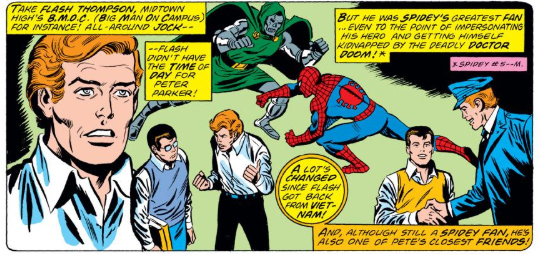 That's Doom's only appearance in the whole story, which makes it a little bit odd that he appears so prominently on the cover, alongside The Lizard, Doctor Octopus and The Kingpin - all much more regular villains in this series, though none as important as the unfeatured Green Goblin. I guess this is just another example of Doctor Doom being a big enough draw for readers to warrant putting on the cover, even when he's hardly in the actual comic itself!
That's Doom's only appearance in the whole story, which makes it a little bit odd that he appears so prominently on the cover, alongside The Lizard, Doctor Octopus and The Kingpin - all much more regular villains in this series, though none as important as the unfeatured Green Goblin. I guess this is just another example of Doctor Doom being a big enough draw for readers to warrant putting on the cover, even when he's hardly in the actual comic itself!
posted 30/10/2019 by MJ Hibbett
(click here for permanent link)
(0) comments
Like A Diamond In The Sky!
Only a single panel appearance from Doctor Doom in this story, which starts with another of those warnings to the reader that they haven't picked up the wrong comic:
 I assume this story is carried over from an issue of The Avengers, though oddly there's no footnotes to say so, at least not in the Marvel Unlimited version. The story itself sees Thor and Iron Man leaving the other Avengers behind in a spaceship while they fly out to stop a computer called Faust from destroying the planet. To be honest it all seems like a pretty straightforward fight, but it does cause quite a lot of laser beams and explosions to go off in the skies around the world, and these are noticed by a selection of very mid-70s Marvel characters, including Captain Marvel, Spider-man, Nova, Daredevil, Shang-Chi and of course Doctor Doom.
I assume this story is carried over from an issue of The Avengers, though oddly there's no footnotes to say so, at least not in the Marvel Unlimited version. The story itself sees Thor and Iron Man leaving the other Avengers behind in a spaceship while they fly out to stop a computer called Faust from destroying the planet. To be honest it all seems like a pretty straightforward fight, but it does cause quite a lot of laser beams and explosions to go off in the skies around the world, and these are noticed by a selection of very mid-70s Marvel characters, including Captain Marvel, Spider-man, Nova, Daredevil, Shang-Chi and of course Doctor Doom.
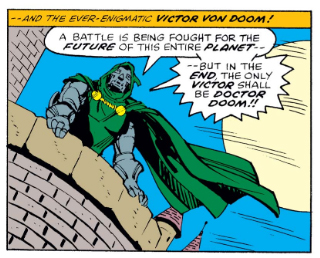 Is he making the "Victor" pun on purpose, do you think?
Is he making the "Victor" pun on purpose, do you think?
That list of charcters is quite interesting - every one of them apart from Doom has a series of his own, which might signify his existence as a roving character, especially compared to Nova and Shang-Chi (and to some extent Captain Marvel) who are lesser characters there to remind readers of their existence. Also, as ever in these situations, Doom is there to show that the battle is being watched all over the world, not just in New York.
That's all the Doom we get in this issue, and there's not a whole lot more to come next time, in a prime example of Bill Mantlo's "Dreaded Deadline Doom" work!
posted 28/10/2019 by MJ Hibbett
(click here for permanent link)
(0) comments
Star Jaws!
After the incomprehensible madness of The Phoenix Gambit it's a relief to be back in the comparatively calm and sensible world of "Spidey Super Stories", with a thoroughly enjoyabe riff on "Star Wars" that kicks off with a cover cleverly echoing the movie's own poster.
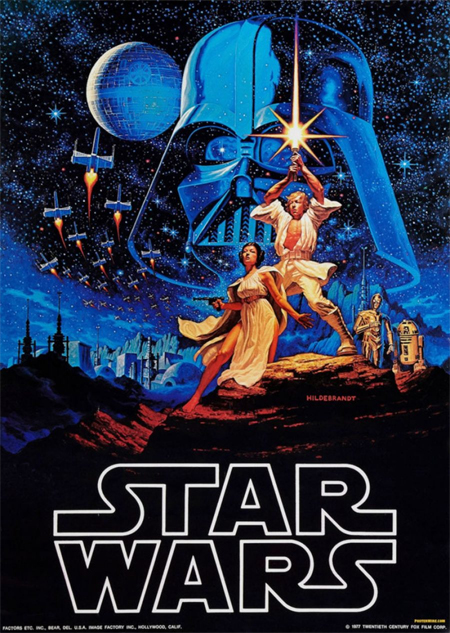 The film had been out for several months when this comic hit the newsstands, but was still dominating the cinema and was, clearly, becoming a great pull for younger readers. The poster recasts Spider-man as Luke Skywalker, Moondragon as Princess Leia, and Doctor Doom as Darth Vader - ironically, as Darth Vader was at least partly based on Doom. The story within also casts characters from the Electric Company TV show as R2-D2 and Chewbacca, with Marvel Boy (for some reason) brought in to play Han Solo and Doombots brought in as Storm Troopers. The Millenium Falcon, meanwhile, is played by... well, basically, the Millenium Falcon.
The film had been out for several months when this comic hit the newsstands, but was still dominating the cinema and was, clearly, becoming a great pull for younger readers. The poster recasts Spider-man as Luke Skywalker, Moondragon as Princess Leia, and Doctor Doom as Darth Vader - ironically, as Darth Vader was at least partly based on Doom. The story within also casts characters from the Electric Company TV show as R2-D2 and Chewbacca, with Marvel Boy (for some reason) brought in to play Han Solo and Doombots brought in as Storm Troopers. The Millenium Falcon, meanwhile, is played by... well, basically, the Millenium Falcon.
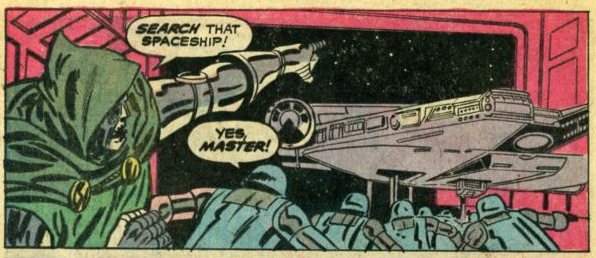 The story sees Doctor Doom in charge of a space station "as big as a planet" (it's no moon....), where he uses his army of Doombots/Storm Troopers to capture Moondragon.
The story sees Doctor Doom in charge of a space station "as big as a planet" (it's no moon....), where he uses his army of Doombots/Storm Troopers to capture Moondragon.
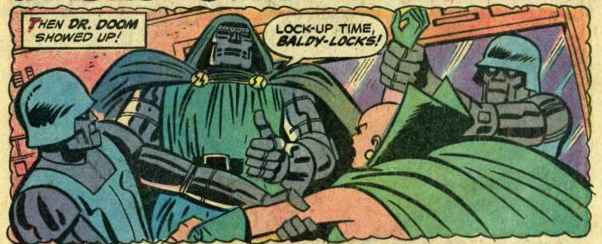 Sam The Sesame Street Robot escapes and seeks Spider-man's help, so go and find Marvel Boy filming a movie, and then jump into the Millenium Falcon and fly off. As ever with Spidey Super Stories, there's a childish dream-like logic to it all, as they use a spaceship that may or may not be a movie prop to fly up into Doctor Doom's space station. It has a gigantic mouth across the middle so, of course, he's called it "Star Jaws".
Sam The Sesame Street Robot escapes and seeks Spider-man's help, so go and find Marvel Boy filming a movie, and then jump into the Millenium Falcon and fly off. As ever with Spidey Super Stories, there's a childish dream-like logic to it all, as they use a spaceship that may or may not be a movie prop to fly up into Doctor Doom's space station. It has a gigantic mouth across the middle so, of course, he's called it "Star Jaws".
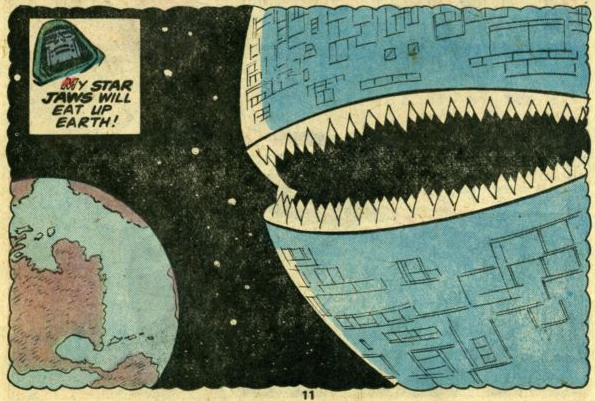 Marvel Boy and Spider-man disguise themselves as robots, allowing them to help Moondragon and the others escape back to the Millenium Falcon. However, Spider-man gets stuck on the way and ends up fighting Doctor Doom using handily placed Light Sabers.
Marvel Boy and Spider-man disguise themselves as robots, allowing them to help Moondragon and the others escape back to the Millenium Falcon. However, Spider-man gets stuck on the way and ends up fighting Doctor Doom using handily placed Light Sabers.
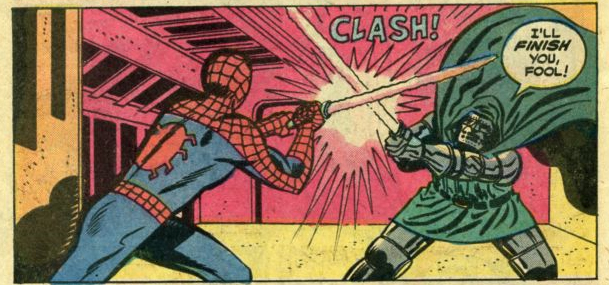 The plot has largely followed that of the movie at this point, but deviates here by having Spidey survive the flight, allowing the heroes to escape. Doctor Doom isn't that bothered.
The plot has largely followed that of the movie at this point, but deviates here by having Spidey survive the flight, allowing the heroes to escape. Doctor Doom isn't that bothered.
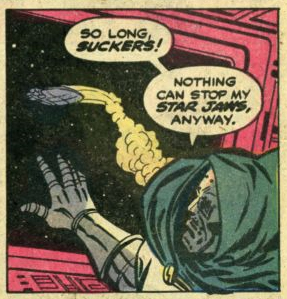 Apart from the (very amusing) use of language throughout, the Spidey Super Stories version of Doom is, as ever, close to the main Marvel Universe incarnation of the character, with his reliance on cunning plans and happiness to sword fight. Sadly for him he's beaten by an even more cunning plan, as The Pentagon release one million tons of TNT into space which Moon Dragon then disguises as planet Earth so that Star Jaws will bite it.
Apart from the (very amusing) use of language throughout, the Spidey Super Stories version of Doom is, as ever, close to the main Marvel Universe incarnation of the character, with his reliance on cunning plans and happiness to sword fight. Sadly for him he's beaten by an even more cunning plan, as The Pentagon release one million tons of TNT into space which Moon Dragon then disguises as planet Earth so that Star Jaws will bite it.
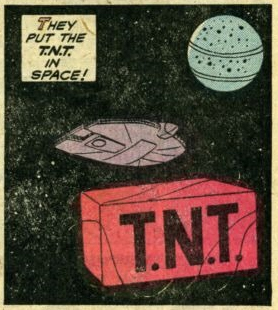 As I said, it's a very childish, dream-like logic, but it still makes more sense than "Masters Of Kung-Fu" did!
As I said, it's a very childish, dream-like logic, but it still makes more sense than "Masters Of Kung-Fu" did!
The plan works, as Star Jaws eats the TNT and explodes, leading Doom to float off into space with a few Doombots beside him, something which harks back to some of his earliest appearances back in Fantastic Four #6, >Fantastic Four #17 and Fantastic Four #23.
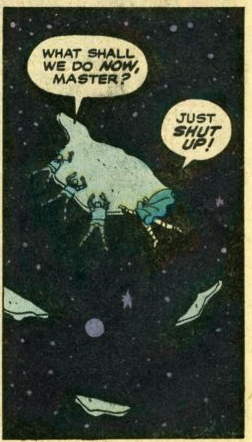
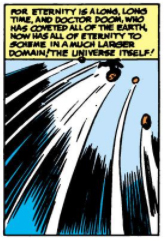
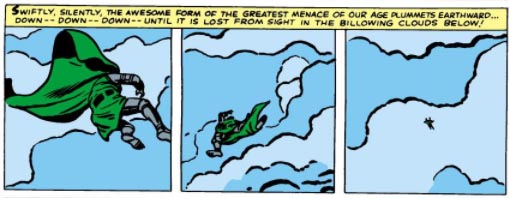
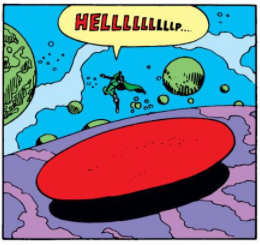 The comic is so full of story that it continues onto the inner covers - this was the only time Spidey Super Stories featured one continuous story rather than several - and it's a joy from start to finish. Doom is very much Doom, and the pastiche has a huge amount of fun using existing characters from Marvel and Sesame Street to retell the story. The only thing it doesn't do, which I would have liked, is to mention quite how similar Darth Vader is to Doctor Doom, but otherwise it's been the most enjoyable issue since Doom fought Kiss!
The comic is so full of story that it continues onto the inner covers - this was the only time Spidey Super Stories featured one continuous story rather than several - and it's a joy from start to finish. Doom is very much Doom, and the pastiche has a huge amount of fun using existing characters from Marvel and Sesame Street to retell the story. The only thing it doesn't do, which I would have liked, is to mention quite how similar Darth Vader is to Doctor Doom, but otherwise it's been the most enjoyable issue since Doom fought Kiss!
posted 25/10/2019 by MJ Hibbett
(click here for permanent link)
(0) comments
The Phoenix Gambit: End-game
After the shock reveal of Doom's involvement at the end of the previous issue of Master Of Kung Fu, this one starts with a double dose of him looming threateningly over the other characters, both on the cover and the splash page.
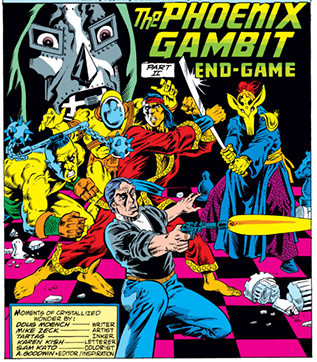 Shang Chi is on the way to Latveria with his friends to try and find out what's going on, but on the way he falls asleep and has a Mystical Dream about his father Fu Manchu and... dinosaurs?
Shang Chi is on the way to Latveria with his friends to try and find out what's going on, but on the way he falls asleep and has a Mystical Dream about his father Fu Manchu and... dinosaurs?
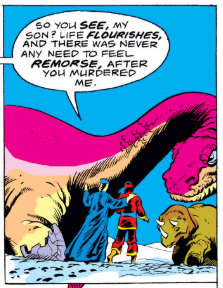 Actually it turns out to be a dragon, which kills Shang Chi, causing him to wake up in a sweat. He sweats a LOT during these two issues, does Shang Chi - is it part of his superpowers?
Actually it turns out to be a dragon, which kills Shang Chi, causing him to wake up in a sweat. He sweats a LOT during these two issues, does Shang Chi - is it part of his superpowers?
They land in Latveria, where a confused (and still sweaty) Shang Chi tries to remember how he got into the plane in the first place. Before he can work it out, however, he and his friend Reston are attacked by a samuri robot who kills Reston... who also turns out to have been a robot.
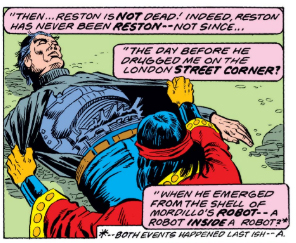 Shang Chi then fights his way into the castle, beating up lots more robots, until he faces someone called Shadow Stalker who has a double headed mace in his hair (for some reason). They fight, Shang Chi wins, and then a wall opens to reveal The Prime Mover and an absolutely delighted Doctor Doom.
Shang Chi then fights his way into the castle, beating up lots more robots, until he faces someone called Shadow Stalker who has a double headed mace in his hair (for some reason). They fight, Shang Chi wins, and then a wall opens to reveal The Prime Mover and an absolutely delighted Doctor Doom.
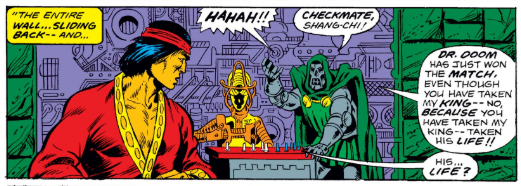 It turns out that Shadow Stalker was NOT a robot, which means that Shang Chi has killed somebody! This is surely the most dick move of all dick moves ever undertaken by Doctor Doom, and Shang Chi asks the question we all want answering - "Why?"
It turns out that Shadow Stalker was NOT a robot, which means that Shang Chi has killed somebody! This is surely the most dick move of all dick moves ever undertaken by Doctor Doom, and Shang Chi asks the question we all want answering - "Why?"
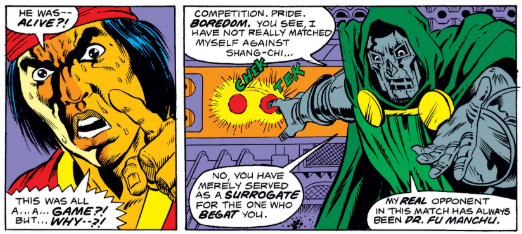 It's interesting to see an artist like Mike Zeck at such an early stage of his career here - he would go on to have such a distinctive style, but here is relying on several swipes to get by. Last time it was from Jim Steranko, this time it's from John Buscema in Thor #183:
It's interesting to see an artist like Mike Zeck at such an early stage of his career here - he would go on to have such a distinctive style, but here is relying on several swipes to get by. Last time it was from Jim Steranko, this time it's from John Buscema in Thor #183:
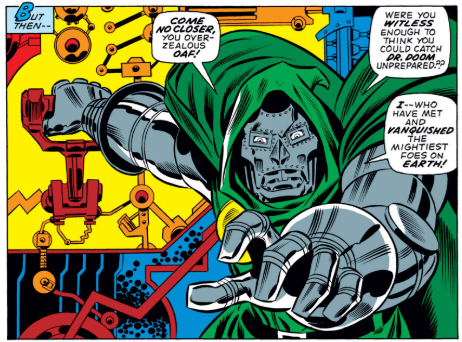 (or maybe this is a swipe of swipe of the swipe by Dick Ayers in Incredible Hulk #143!)
(or maybe this is a swipe of swipe of the swipe by Dick Ayers in Incredible Hulk #143!)
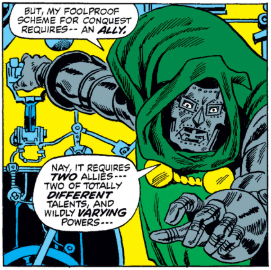 Doom seems to think this means he has won, and so all that's left to do is set all the spare robots on Shang Chi. During the course of beating them up, one of the robots - a man in a lady's swimming costume who has swords instead of hands - cuts through the body of the original Shadow Stalker, who turns out to have been a robot all along.
Doom seems to think this means he has won, and so all that's left to do is set all the spare robots on Shang Chi. During the course of beating them up, one of the robots - a man in a lady's swimming costume who has swords instead of hands - cuts through the body of the original Shadow Stalker, who turns out to have been a robot all along.
 This leads to a final big fight between Doom and Shang Chi at the end of which - well, you'll never guess what happens!
This leads to a final big fight between Doom and Shang Chi at the end of which - well, you'll never guess what happens!
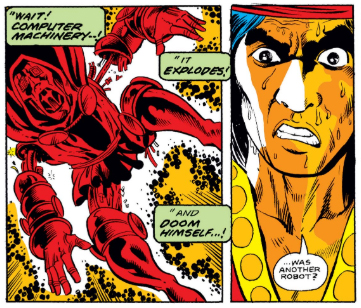 The Prime Mover starts to explode from all the madness (I know how he feels) and falls on the floor, where he turns out not to be the Prime Mover either, but actually Shang Chi's friend Reston in a robot costume, Reston, for some reason, attacks Shang Chi and the pair of them fall out of the window of Doom's castle which inevitably turns out not to be a castle after all but in fact a rocket flying over London.
The Prime Mover starts to explode from all the madness (I know how he feels) and falls on the floor, where he turns out not to be the Prime Mover either, but actually Shang Chi's friend Reston in a robot costume, Reston, for some reason, attacks Shang Chi and the pair of them fall out of the window of Doom's castle which inevitably turns out not to be a castle after all but in fact a rocket flying over London.
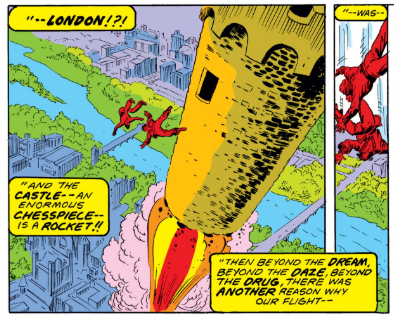 We then cut to a hospital bed where SHang Chi and Reston's boss tells them that he doesn't have a clue what was going on either - and who amongst us can say otherwise? At this point a nurse comes in to deliver a get well present which turns out to be a chess set, with a laughing model of Doctor Doom in the middle.
We then cut to a hospital bed where SHang Chi and Reston's boss tells them that he doesn't have a clue what was going on either - and who amongst us can say otherwise? At this point a nurse comes in to deliver a get well present which turns out to be a chess set, with a laughing model of Doctor Doom in the middle.
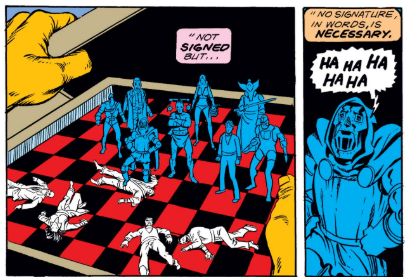 And that's the end, except for a repeat of the final panel from last time, this time presumably showing the real Doctor Doom and Primer Mover, still at their game.
And that's the end, except for a repeat of the final panel from last time, this time presumably showing the real Doctor Doom and Primer Mover, still at their game.
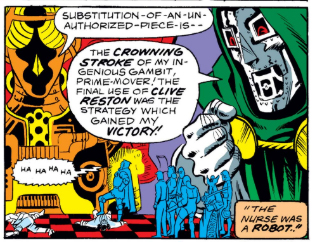 I have absolutely no idea what this is all meant to be about - was Doom just messing around with Shang Chi and his pals for the fun of it? As far as I'm aware the two characters do not meet again, so it wasn't part of a big plan, so what was it meant to achieve? And why was the whole thing called "The Phoenix Gambit"?
I have absolutely no idea what this is all meant to be about - was Doom just messing around with Shang Chi and his pals for the fun of it? As far as I'm aware the two characters do not meet again, so it wasn't part of a big plan, so what was it meant to achieve? And why was the whole thing called "The Phoenix Gambit"?
I think it's fair to leave the final word to Reston, who sums the whole thing up for me in the penultimate panel:
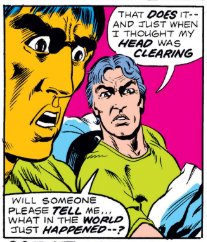
posted 23/10/2019 by MJ Hibbett
(click here for permanent link)
(1) comments
The Way It Was!
This is a hugely important comic for me and this blog (though probably not for anybody else) as it's the 147th text the (long) list of 293 items which currently make up the corpus, and so marks the halfway point for my reading. Of course, this isn't an exact number - the 293 items includes everything I've collected, so there are some comics in that number that, it turns out, don't feature Doctor Doom at all, and also doesn't include the inevitable extra items that will doubtless turn up in the future. However, while the numbers may change either way I think that this is still a pretty good place to point to and say "We're halfway there!"
After two years of blogging it's a cause for some celebration to have got this far, but it's also a reminder that I'm going to have to increase the frequency of updated if I'm going to have any chance of handing in my PhD on time!
Another reason for it being important is that it also marks the start of the third "phase" of The Marvel Age, with the arrival of Jim Shooter as editor-in-chief. Part of the aforementioned PhD involves using a Culture Of Production approach to define "The Marvel Age" as a distinct period of Marvel comics, and superhero comics in general, started with the first issue of "The Fantastic Four" in 1961 and ending with the last month of comics with Jim Shooter as editor-in-chief in 1987. Within this there are three seperate phases - "Creation", with Stan Lee as editor-in-chief, "Chaos", beginning in 1972 and running through five seperate editors-in-chief until 1978 when Jim Shooter takes over and we enter "Consolidation". There's all sorts of arguments as to why this is A Thing and why it matters which I'll not bore you with here, but suffice to say we're about to enter into a very different version of Marvel Comics, both from the preceding few years of "chaos" and indeed from its origins in the 1960s.
Sadly, the actual comic that marks this changeover isn't very special at all. It's a re-telling of most of the history of The Fantastic Four so far, which includes a single panel retelling of Doom's first appearance in Fantastic Four #5 and then about half a page later on covering the time the Thing nearly killed him in Fantastic Four #40.
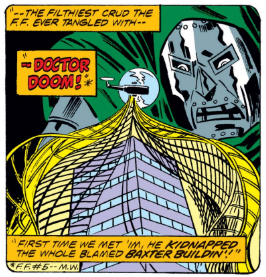 Doom also appears on the cover, drawn by his creator Jack Kirby, illustrating how important he's been to the history of the team even if he doesn't appear very much on the pages of this issue. The story, such that it is, happens just after The Fantastic Four have split up for good (again). The Thing goes through his diary, telling Alicia about all of the times this has happened in the past. She, very understandably, points out that this shows that The Fantastic Four will always get back together again (SPOILERS: they will), but The Thing dismisses the idea and suggests they go out and get something to eat.
Doom also appears on the cover, drawn by his creator Jack Kirby, illustrating how important he's been to the history of the team even if he doesn't appear very much on the pages of this issue. The story, such that it is, happens just after The Fantastic Four have split up for good (again). The Thing goes through his diary, telling Alicia about all of the times this has happened in the past. She, very understandably, points out that this shows that The Fantastic Four will always get back together again (SPOILERS: they will), but The Thing dismisses the idea and suggests they go out and get something to eat.
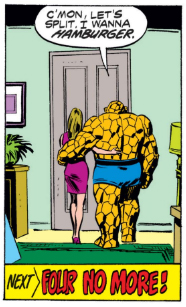 And that's all there is to it - a very downbeat, intentionally low-key ending to what has been a fairly low-key story, even though it contains versions of some of the series' most well known adventures. It's a shame but not to worry - Doom will be back in the pages of The Fantastic Four very soon, in a genuinely exciting and epic story that kicks off some major changes for Doom in the coming few years, Next time, however, we're looking at a brand new series for this blog, as Doom makes a brief appearance in the distinctly weird pages of 'Master Of Kung Fu'!
And that's all there is to it - a very downbeat, intentionally low-key ending to what has been a fairly low-key story, even though it contains versions of some of the series' most well known adventures. It's a shame but not to worry - Doom will be back in the pages of The Fantastic Four very soon, in a genuinely exciting and epic story that kicks off some major changes for Doom in the coming few years, Next time, however, we're looking at a brand new series for this blog, as Doom makes a brief appearance in the distinctly weird pages of 'Master Of Kung Fu'!
posted 17/10/2019 by MJ Hibbett
(click here for permanent link)
(0) comments
The Phoenix Gambit: The Temples Of Time
This is a really rather strange comic which did not appear in my original corpus at all. Doctor Doom is very much present in the story (including a very subtle hint to his presence on the cover), although not until the very last page, so the only explanation for his absence that I can think of is that none of the original indexers managed to get to the end. Having had to do so, I fully sympathise! I only realised that Doom might be in this comic because he appears in the next issue as if he's already been introduced. That comic, as we'll see soon, made almost no sense whatsoever, so I was hoping that reading this one might give a clue to what was happening, but if anything I came away even more confused!
The story exists in a weird, almost druggy, state, with Shang Chi wandering around meeting Strange Figures who say Mystical Things, all heavily narrated in that "hip" mid-70s style that would reach its high point in the next decade with Alan Moore's run on "Swamp Thing".
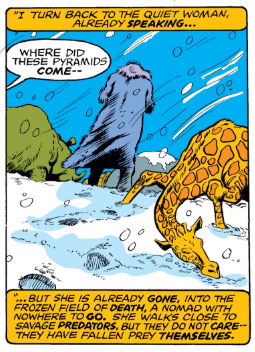 Shang Chi spends a lot of time sweating as he wakes up in Marvel's version of London, full of "blokes" and "bloody"-spouting bobbies drawn by a young Mike Zeck, who hasn't turned into the artist who would gain fame a few years later on Captain America, and also who clearly hasn't ever been to London! In the midst of all the confused, sweaty weirdness there's one small panel which cuts away to a view of a castle which, as yet, hasn't been mentioned.
Shang Chi spends a lot of time sweating as he wakes up in Marvel's version of London, full of "blokes" and "bloody"-spouting bobbies drawn by a young Mike Zeck, who hasn't turned into the artist who would gain fame a few years later on Captain America, and also who clearly hasn't ever been to London! In the midst of all the confused, sweaty weirdness there's one small panel which cuts away to a view of a castle which, as yet, hasn't been mentioned.
 There's more dreams, a pyramid, a spaceship, some kind of angel, and a whip-weilding woman in her pants who turns out to be a robot before we get another shot of the castle, this time with two silhouetted figures visible at a window.
There's more dreams, a pyramid, a spaceship, some kind of angel, and a whip-weilding woman in her pants who turns out to be a robot before we get another shot of the castle, this time with two silhouetted figures visible at a window.
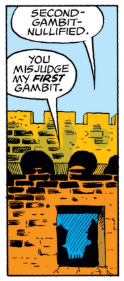 The whole story is so disjointed and incoherent that these cutaways slip by unnoticed - nothing else fits as a plot so the reader doesn't really notice that these are meant to be anything different! Things continue in this vein for the rest of the issue, with Shang Chi continuing to sweat an awful lot as he fights yet another robot who, this time, turns out to be someone he knows who is inside a robot costume, and is just as confused as anyone else.
The whole story is so disjointed and incoherent that these cutaways slip by unnoticed - nothing else fits as a plot so the reader doesn't really notice that these are meant to be anything different! Things continue in this vein for the rest of the issue, with Shang Chi continuing to sweat an awful lot as he fights yet another robot who, this time, turns out to be someone he knows who is inside a robot costume, and is just as confused as anyone else.
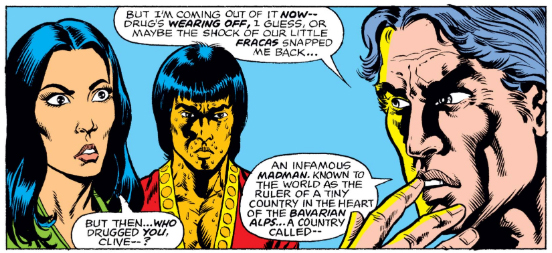 It all feels like an attempt to copy the structured weirdness of a Jim Steranko comic... which is exactly what it turns out to be as the very last panel reveals that our mysterious game players in the castle were none other than Doctor Doom and The Prime Mover!
It all feels like an attempt to copy the structured weirdness of a Jim Steranko comic... which is exactly what it turns out to be as the very last panel reveals that our mysterious game players in the castle were none other than Doctor Doom and The Prime Mover!
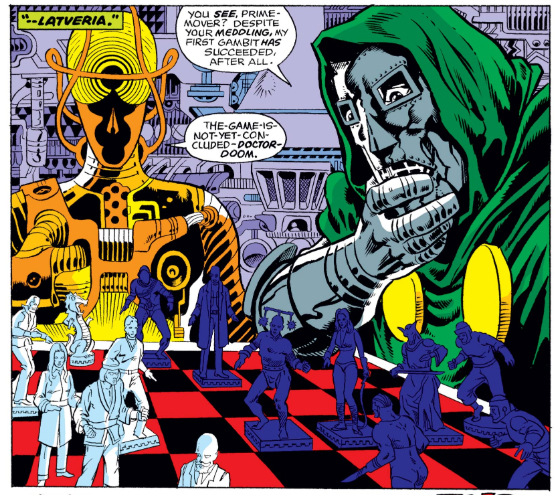 This is a homage to Doom and The Primer Mover's shock reveal at the end of Strange Tales #167:
This is a homage to Doom and The Primer Mover's shock reveal at the end of Strange Tales #167:
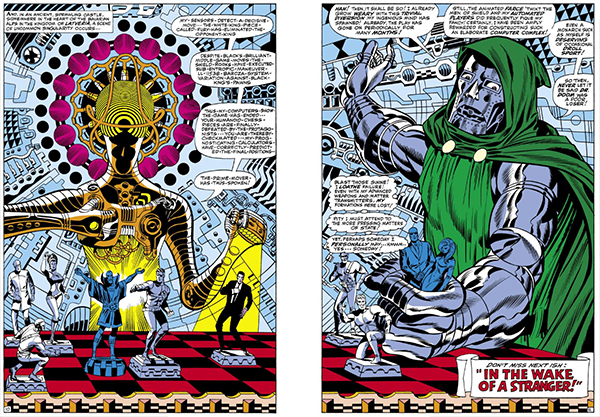 "More than mildly mystified and stunned enough people?" asks the next time box, "Or are ya craving more of this weirdness?" I definitely feel mystified but can't say I'm craving more!
"More than mildly mystified and stunned enough people?" asks the next time box, "Or are ya craving more of this weirdness?" I definitely feel mystified but can't say I'm craving more!
Luckily for all concerned, before we delve into the next issue there's a very different comic too look at which marks a major milestone for this whole project - next time!
posted 15/10/2019 by MJ Hibbett
(click here for permanent link)
(0) comments
Kiss!
Nowadays a tie-in comic like this would probably be dashed off as a cheap knock-off designed to grab a few quid off a band's fans with little or no care given to what's actually inside, but this is something quite different all together. I mean, it's not something you'd ever read if you weren't a mad Kiss fan (or a serious scholar looking at important Doctor Doom appearances, OBVS) but everything about it is properly done by proper comics professionals at the top of their game including Steve Gerber, both Buscema brothers, Allan Weiss and Rich Buckler.
What's most interesting, from my point of view, is how much Gerber seeks to embed Marvel continuity (especially Doctor Doom) into the whole story, as an attempt to get Kiss fans to read comics. The story features members of Kiss talking about how brilliant comics are, and there are constant nudges towards the wider world of Marvel, including a grand tour around the Marvel Universe featuring guest appearances by Spider-man, The Fantastic Four, The Avengers and (probably because Steve Gerber was writing them around this time) The Defenders. There's even some rather jolly textual material about Doctor Doom, notably an Actually Quite Funny joke-advert for trips on Air Latveria
 Doom doesn't appear until nearly halfway through the story, but his appearance is heralded on the back cover and, a few pages in, via a text version of his origin, heavily based on Fantastic Four Annual #2. The only difference from that version is that here Doom is clearly located in time, stating that he was born in the 1920s and that he went to Tibet after his accident rather than returning to Latveria because it was during World War Two. It's an interesting way to justify the original story which directly contradicts the usual date-avoidant policy of Marvel's sliding timeline. I know that Doom's appearing soon in an issue of The Invaders though, so we'll see if this timeline is upheld there (SPOILERS: don't hold your breath).
Doom doesn't appear until nearly halfway through the story, but his appearance is heralded on the back cover and, a few pages in, via a text version of his origin, heavily based on Fantastic Four Annual #2. The only difference from that version is that here Doom is clearly located in time, stating that he was born in the 1920s and that he went to Tibet after his accident rather than returning to Latveria because it was during World War Two. It's an interesting way to justify the original story which directly contradicts the usual date-avoidant policy of Marvel's sliding timeline. I know that Doom's appearing soon in an issue of The Invaders though, so we'll see if this timeline is upheld there (SPOILERS: don't hold your breath).
The first part of this issue is taken up with an origin story for Kiss, where a group of working class teenagers find a Mystical Box while trying to protect an old man from some muggers. They are transformed into the band Kiss, who already look like Superheroes so, in the Marvel Universe, are exactly that, powers and all.
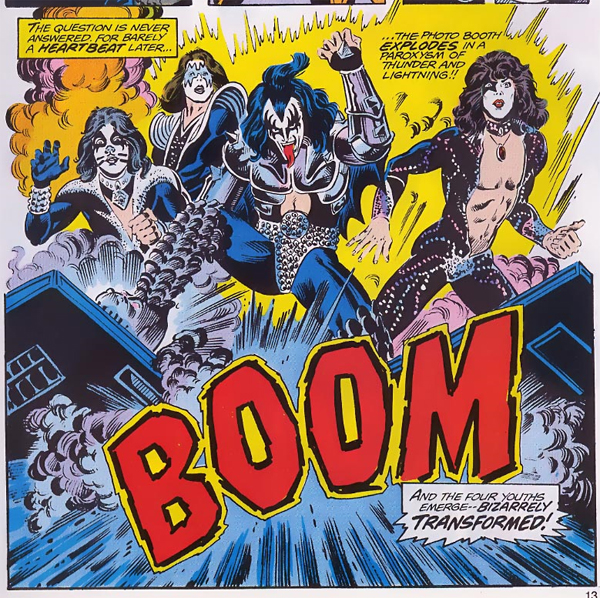 Doom arrives (in a spaceship disguised as a full-moon!) heralded by a group of "Gypsy maidens, each more alluring than the one before, scattering delicate petals for their master's boot to trample!"
Doom arrives (in a spaceship disguised as a full-moon!) heralded by a group of "Gypsy maidens, each more alluring than the one before, scattering delicate petals for their master's boot to trample!"
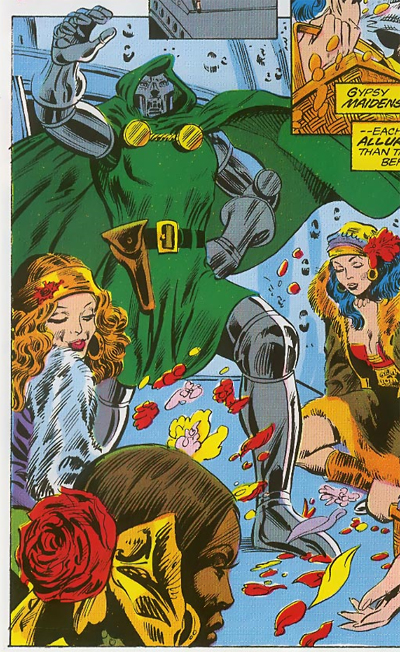 This is a new look for Doom, but one that makes a surprising amount of sense, as he acknowledges his own past as the son of a gypsy sorcerous. It turns out that the mystical box - The Box Of Khyscz - actually belonged to his mother, but was removed by one of his gypsy tribe because it was too dangerous for Doom to keep for himself. This, again, is neatly tied into his origin, where we saw his family friend Boris realising the danger in him early on - Boris clearly wasn't the only one to realise this, although the only one to actually do something about it.
This is a new look for Doom, but one that makes a surprising amount of sense, as he acknowledges his own past as the son of a gypsy sorcerous. It turns out that the mystical box - The Box Of Khyscz - actually belonged to his mother, but was removed by one of his gypsy tribe because it was too dangerous for Doom to keep for himself. This, again, is neatly tied into his origin, where we saw his family friend Boris realising the danger in him early on - Boris clearly wasn't the only one to realise this, although the only one to actually do something about it.
There's more classic Doom action next, as Doom leaves his minions to fight for him and they turn out to be robots!
 Again, this is a new twist on an old trope, and one I hope returns in the more mainstream version of the character!
Again, this is a new twist on an old trope, and one I hope returns in the more mainstream version of the character!
Kiss use their own powers to try and give chase, but accidentally end up being split up, with two of them teleporting off to Hell to meet Mephisto, and the others ending up in a Space Disco. This is all filler, to be honest, and after the required number of pages are used up they telport back together again to Latveria where they are greeted by "Dizzy The Hun", the mystic who gave them the box in the first place. He doesn't have time to explain his name, or how he got to the other side of the planet, because he needs to quickly tell them that all of their experiences so far have been a training exercise to get them ready to fight Doctor Doom. This begins immediately, as they're attacked by a troupe of robot monks.
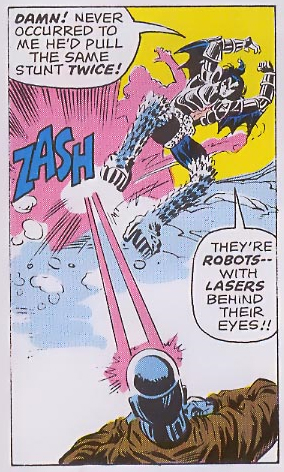 They then get sucked into some giant stone lips (I have no idea what's going on with this bit) and end up in space, where Doom immediately beats 75% of them up.
They then get sucked into some giant stone lips (I have no idea what's going on with this bit) and end up in space, where Doom immediately beats 75% of them up.
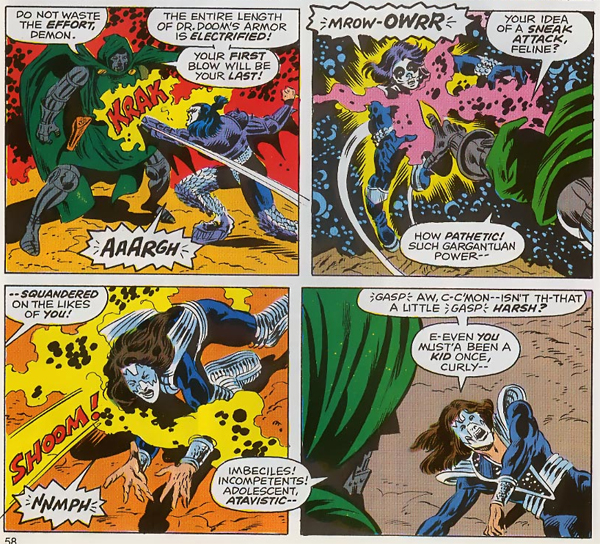 He's stopped by Ace Frehley, who points out that Doom was once a kid himself. This distracts Doom long enough for Paul Stanley to blast him with an Emotion Ray from his Star Eye, which leads to an extremely interesting insight into Doom's own origin.
He's stopped by Ace Frehley, who points out that Doom was once a kid himself. This distracts Doom long enough for Paul Stanley to blast him with an Emotion Ray from his Star Eye, which leads to an extremely interesting insight into Doom's own origin.
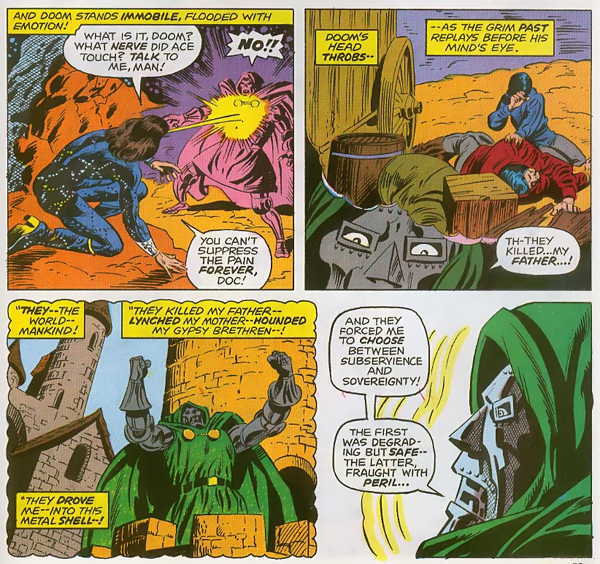 This is a fascinating (and brief) psyhoanalysis of Doom which gives clear motivation for all of his actions, which is an odd thing to find in a tie-in comic with a heavy metal band! If part of the idea of this comic is to show Kiss fans what Marvel comics are really like, though, this really works.
This is a fascinating (and brief) psyhoanalysis of Doom which gives clear motivation for all of his actions, which is an odd thing to find in a tie-in comic with a heavy metal band! If part of the idea of this comic is to show Kiss fans what Marvel comics are really like, though, this really works.
Vinny The Hun reappears and takes things further, by telling Doom that he must recognise the worth of these youths.
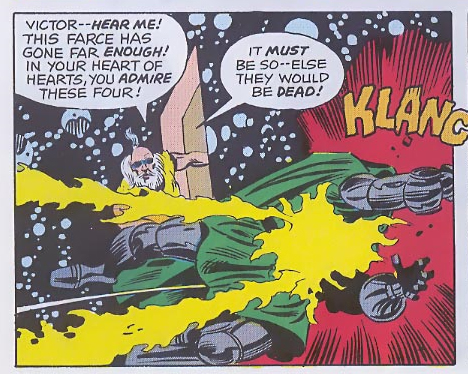 It's strange to see Kiss being talked about this way, as nowadays they're a bunch of wizened old pensioners, but I suppose even they must have been young once! Doom refuses to accept this analysis and is about to strike down the old mystic, before realising that he can't bring himself to do it.
It's strange to see Kiss being talked about this way, as nowadays they're a bunch of wizened old pensioners, but I suppose even they must have been young once! Doom refuses to accept this analysis and is about to strike down the old mystic, before realising that he can't bring himself to do it.
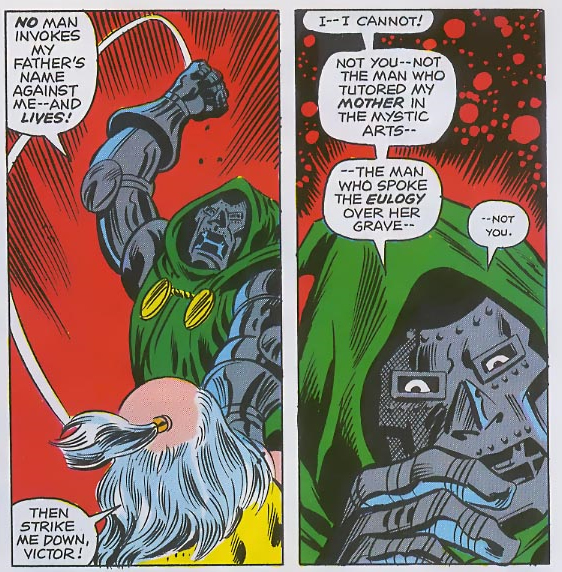 Yet more continuity here, as we discover that Vinny The Hun gave the euology at his mother's funeral. I really hope this comes up again in a mainstream comic so it counts as canon!
Yet more continuity here, as we discover that Vinny The Hun gave the euology at his mother's funeral. I really hope this comes up again in a mainstream comic so it counts as canon!
Unable to kill the old man Doom instead banishes him and Kiss from "this land", which is fine for everyone as they never really wanted to be on a space rock in the first place. "You've won more than you suspect this day", says Vinny to Doom as they depart, and then that's it. There's one more page about Kiss deciding to Use Their Powers For Good and then all we're left with is an inside cover about how the comic was put together (including an acknowledgement that "the deadly deadline doom" forced them to use several pencilers) and we're left with a back page illustration of a very pensive Doom, watching from his space rock.
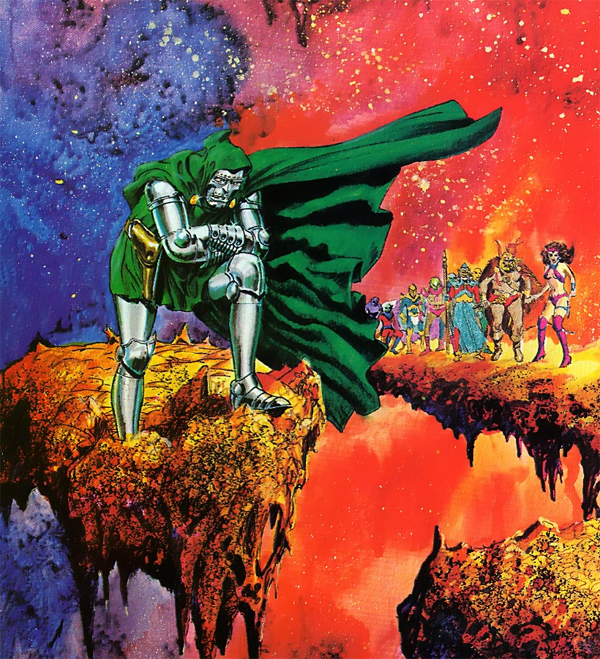 This has been a (very) surprising comic to read - I thought it would be a tatty piece of merchandising designed to fleece some money out of Kiss fans, but it's actually a well thought out attempt to integrate them into the Marvel Universe in which Doctor Doom (as so often happens) comes close to becoming the main narrative focus. It introduces a couple of new twists on Doom himself and makes some insightful observations about his motivations too. We can only hope there's more of this to come - any chance of Doctor Doom fighting the Scorpions soon?
This has been a (very) surprising comic to read - I thought it would be a tatty piece of merchandising designed to fleece some money out of Kiss fans, but it's actually a well thought out attempt to integrate them into the Marvel Universe in which Doctor Doom (as so often happens) comes close to becoming the main narrative focus. It introduces a couple of new twists on Doom himself and makes some insightful observations about his motivations too. We can only hope there's more of this to come - any chance of Doctor Doom fighting the Scorpions soon?
posted 11/10/2019 by MJ Hibbett
(click here for permanent link)
(0) comments
A World Lost!
This is an important comic in the publication history of Doctor Doom, as it marks the end of a long series of stories starring him as the lead character, beginning seven years earlier in Astonishing Tales #1, moving briefly into Sub-mariner and then continuing in Super-Villain Team-Up. It's been one long run with him as the lead character (or sharing that position with Namor), but after this he returns to being the guest villain in other characters' series.
Which, really, is what he spends most of this story doing, as the focus switches to Magneto and The Beast. They're trying to persuade the mind-controlled Champions to help them defeat Doom but are surpsied to find that this is impossible - despite the fact that they already know that everybody on Earth is under his control. Come on, Magento and The Beast, pay attention!
To be fair to them, it is quite a complicated set-up, and so the editors (who provided the helpful "Read Super-Villain Team-Up" note last time) include a pretty detailed description of what's happened so far, right above the team's logo where the origin blurb would usually go.
 The Champions spend the first five pages in the traditional Big Fight Based On A Misunderstanding, not giving The Beast enough time to explain what's going on. The action then switches to Washington where Doctor Doom is being feted by the White House staff, including a Bob Dylan-quoting Jimmy Carter.
The Champions spend the first five pages in the traditional Big Fight Based On A Misunderstanding, not giving The Beast enough time to explain what's going on. The action then switches to Washington where Doctor Doom is being feted by the White House staff, including a Bob Dylan-quoting Jimmy Carter.
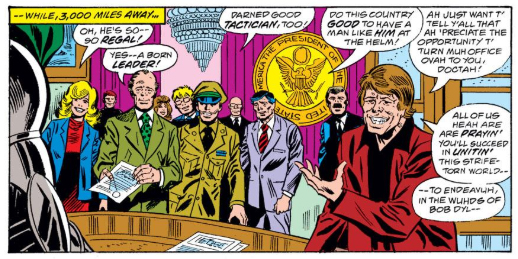 This is, understandably, more than Doom can handle, and he storms out onto the lawns just as the Hulk arrives. Doom's security guards leap to his defence, and Doom thanks them, as he often does, with a slap.
This is, understandably, more than Doom can handle, and he storms out onto the lawns just as the Hulk arrives. Doom's security guards leap to his defence, and Doom thanks them, as he often does, with a slap.
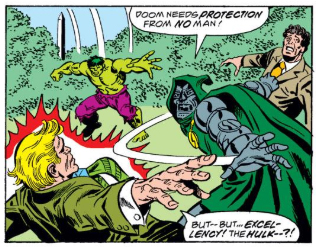 It turns out that Doom has summoned the Hulk to work for him, presumably as some sort of bodyguard, which immediately contradicts what he's just said about not needing protection. The Beast and Magneto arrive, closely followed by The Champions, and then another Big Fight breaks out between all of the superheroes. This only ends when Doom orders The Champions to fight for him, causing great surprise for Ghost Rider.
It turns out that Doom has summoned the Hulk to work for him, presumably as some sort of bodyguard, which immediately contradicts what he's just said about not needing protection. The Beast and Magneto arrive, closely followed by The Champions, and then another Big Fight breaks out between all of the superheroes. This only ends when Doom orders The Champions to fight for him, causing great surprise for Ghost Rider.
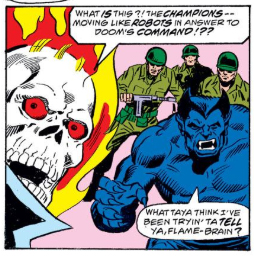 It turns out that he's not affected because, according to an editorial note from Archie Goodwin, "since the hell-spawned Ghost Rider does not breathe, he never inhaled Doom's neuro-gas". It's a neat get-out, which also implies that Doom has no control over robots either. Ghost Rider helps the Beast, and between them they manage to hold the Hulk and the other Champions at bay, leaving Doom and Magneto to fight it out between themselves, in a battle that hints at Bill Mantlo being a secret fan of Jon Pertwee's Doctor Who.
It turns out that he's not affected because, according to an editorial note from Archie Goodwin, "since the hell-spawned Ghost Rider does not breathe, he never inhaled Doom's neuro-gas". It's a neat get-out, which also implies that Doom has no control over robots either. Ghost Rider helps the Beast, and between them they manage to hold the Hulk and the other Champions at bay, leaving Doom and Magneto to fight it out between themselves, in a battle that hints at Bill Mantlo being a secret fan of Jon Pertwee's Doctor Who.
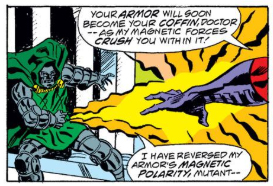 Doom calls in his other minions - the White House staff - to fight for him, forcing the conscious heroes to pull their punches so as not to hurt them. While this is going on Doom prepares to kill the Beast, forcing the Ghost Rider to attack with Hellfire and leading to this rather cartoon-ish image.
Doom calls in his other minions - the White House staff - to fight for him, forcing the conscious heroes to pull their punches so as not to hurt them. While this is going on Doom prepares to kill the Beast, forcing the Ghost Rider to attack with Hellfire and leading to this rather cartoon-ish image.
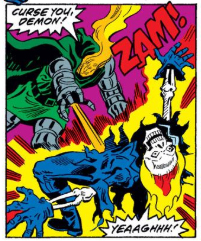 With the inside of his mask burning Doom is forced to take it off. He manages to cover up his face while he does so, but is unable to avoid exposing himself to the neuro gases in the atmosphere.
With the inside of his mask burning Doom is forced to take it off. He manages to cover up his face while he does so, but is unable to avoid exposing himself to the neuro gases in the atmosphere.
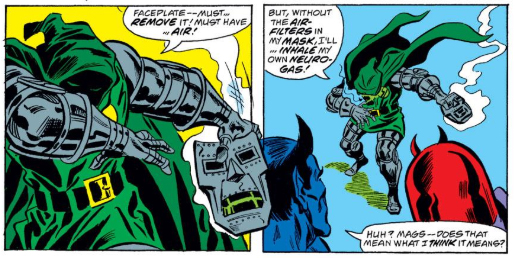 This immediately returns everybody to full consciousness (which doesn't make a huge amount of sense) at which point the Hulk and Magneto, along with the army and White House staff, clear off, leaving the Champions to ponder the immobilised Doctor Doom.
This immediately returns everybody to full consciousness (which doesn't make a huge amount of sense) at which point the Hulk and Magneto, along with the army and White House staff, clear off, leaving the Champions to ponder the immobilised Doctor Doom.
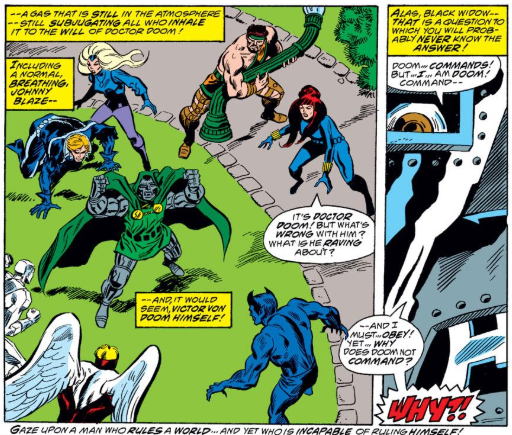 He's stuck in one of those logic loops, like Star Trek used to do - Bill Mantlo clearly does like sci-fi TV! This doesn't make a lot of sense either, but it's a neat twist in a story that's been full of them, with Doom first conquering the world without anybody knowing, only to fall victim to his own devices. In theory the neuro-gas is still in the atmosphere, so if Doom can find a way of giving himself orders he should be back in control, but I have a sneaking suspicion that things won't work out that way. Perhaps we'll find out in the next story, which sees him going up against the soft-rock stylings of ... KISS!
He's stuck in one of those logic loops, like Star Trek used to do - Bill Mantlo clearly does like sci-fi TV! This doesn't make a lot of sense either, but it's a neat twist in a story that's been full of them, with Doom first conquering the world without anybody knowing, only to fall victim to his own devices. In theory the neuro-gas is still in the atmosphere, so if Doom can find a way of giving himself orders he should be back in control, but I have a sneaking suspicion that things won't work out that way. Perhaps we'll find out in the next story, which sees him going up against the soft-rock stylings of ... KISS!
posted 9/10/2019 by MJ Hibbett
(click here for permanent link)
(0) comments
A World For The Winning!
This is Doctor Doom's final appearance in Super-Villain Team-Up, and thus the last time he'll headline (or, rather, co-headline) a series of his own until we get to Secret Wars (which I will definitely be arguing he's the lead character for!).
There are a lot of cameos and guest spots to get through before then though, and also this issue which kicks off with Magneto pushing his way through a crowd of Latverians, who Bob Hall has chosen to show as a strange mix of medieval peasants and hipsters.
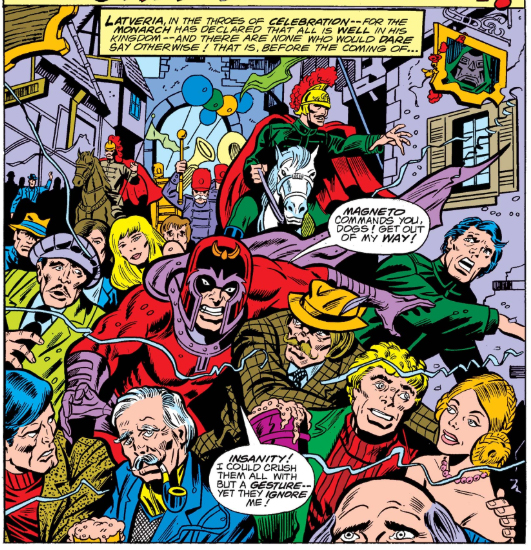 I love the fact that even the pub has a picture of Doctor Doom on its sign! The people are refusing to get out of Magneto's way because they have been ordered by Doom to "rejoice or face his wrath". Magneto gets really annoyed with them, especially when they don't recognise who he is, and he reacts by bringing a statue of Doom toppling to the ground in a weird pre-echo of the revolutions to come to Eastern Europe in 1989.
I love the fact that even the pub has a picture of Doctor Doom on its sign! The people are refusing to get out of Magneto's way because they have been ordered by Doom to "rejoice or face his wrath". Magneto gets really annoyed with them, especially when they don't recognise who he is, and he reacts by bringing a statue of Doom toppling to the ground in a weird pre-echo of the revolutions to come to Eastern Europe in 1989.
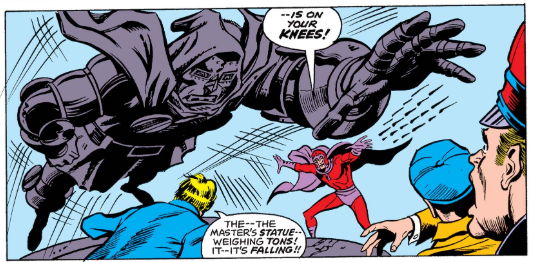 Magneto eventually finds Doom pondering his chess set, last seen very briefly in Giant-Size Defenders #3. It appears to have characters colour coded red and blue, presumably for teams, in which case Spider-man is on Doom's side?
Magneto eventually finds Doom pondering his chess set, last seen very briefly in Giant-Size Defenders #3. It appears to have characters colour coded red and blue, presumably for teams, in which case Spider-man is on Doom's side?
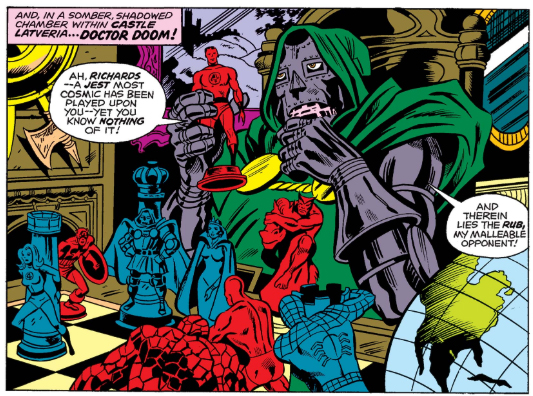 Magneto bursts in, and is pleased to find that Doom recognises him - they haven't met before, except of course in the pages of Not Brand Ecch, so it's a nice ego soother after the locals blanked him. Doom has actually been doing his research on Magneto, and so is able to quiz him on his recent continuity for a while, before he gets distracted by one chess piece in particular.
Magneto bursts in, and is pleased to find that Doom recognises him - they haven't met before, except of course in the pages of Not Brand Ecch, so it's a nice ego soother after the locals blanked him. Doom has actually been doing his research on Magneto, and so is able to quiz him on his recent continuity for a while, before he gets distracted by one chess piece in particular.
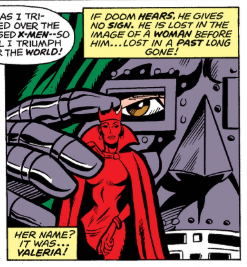 We haven't heard from Valeria in AGES, but sadly this isn't a hint of something to come, it's just Bill Mantlo enjoying some more background character shading. When Doom snaps back to attention Magneto asks for a team-up so they can rule the world together, but Doom states that he already DOES rule the world - he's released gases into the air which mean that the entire planet is under his control!
We haven't heard from Valeria in AGES, but sadly this isn't a hint of something to come, it's just Bill Mantlo enjoying some more background character shading. When Doom snaps back to attention Magneto asks for a team-up so they can rule the world together, but Doom states that he already DOES rule the world - he's released gases into the air which mean that the entire planet is under his control!
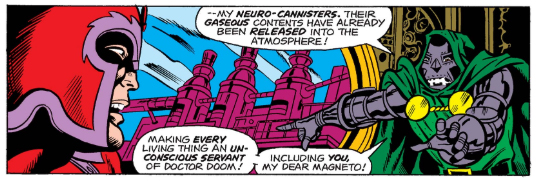 Doom demonstrates by forcing Magneto to kneel and then almost kill himself, and when the Master Of Magnetism asks why he was spared from completing his suicide Doom replies that he's bored!
Doom demonstrates by forcing Magneto to kneel and then almost kill himself, and when the Master Of Magnetism asks why he was spared from completing his suicide Doom replies that he's bored!
 This is a very unusual way to tell a story, with the villain already victorious, having undertaken his world domination plan without telling anybody to make sure nothing goes wrong - he is, after all, not a republic serial villain who would explain his masterstroke, though it seems that he did do it more than thirty-five minutes ago.
This is a very unusual way to tell a story, with the villain already victorious, having undertaken his world domination plan without telling anybody to make sure nothing goes wrong - he is, after all, not a republic serial villain who would explain his masterstroke, though it seems that he did do it more than thirty-five minutes ago.
Doom, however, is not Rorschach either, so he offers Magneto the chance to fight him for world domination, just to keep things interesting. Magneto agrees and then makes the rookie error of sharing a toast with Doom and, inevitably, is knocked unconscious by the drugged drink. Never share a drink with Doctor Doom!
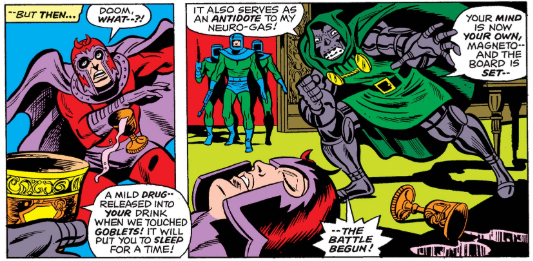 The scene then shifts to Avengers Mansion some hours later, where Magneto arrives seeking aid in his fight to overthrow Doom. Clearly he's not had much practice at this sort of thing. You or I might call ahead, or at least knock on the door and then explain your business, but Magneto just crashes in and rips up the floor, which, as usual, leads to a Big Fight.
The scene then shifts to Avengers Mansion some hours later, where Magneto arrives seeking aid in his fight to overthrow Doom. Clearly he's not had much practice at this sort of thing. You or I might call ahead, or at least knock on the door and then explain your business, but Magneto just crashes in and rips up the floor, which, as usual, leads to a Big Fight.
Once that's all done with Magneto explains what's going on, but before anyone can leap into action a holographic image of Doom appears which commands the Avengers to kneel before him.
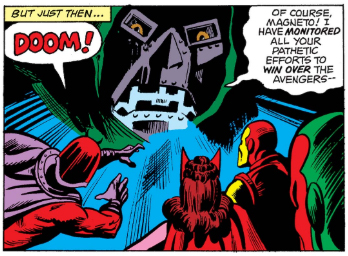 This is several recurrent Doom characteristics for the price of one - he's communicating from a distance, his face is looming huge over the action, and he's using mind control to get what he wants!
This is several recurrent Doom characteristics for the price of one - he's communicating from a distance, his face is looming huge over the action, and he's using mind control to get what he wants!
He also acts in a sportsmanlike way, or at least his version of it, telling Magneto that if he can free the mind of one of the Avengers than he will stay free to act as an ally. Magneto selects the Beast, magnetically floating him into a stolen Quinjet, and then using his mind control powers (duly backed up by a footnote to Avengers #111) to extract the hypno gas using magnetism.
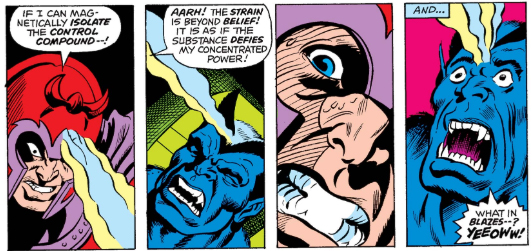 Yep, that makes perfect sense! The pair of them then zoom around Manhattan looking for more allies, despite the fact that Doom has very clearly told them that every other person on the planet is under his control. The issue ends with them flying to Los Angeles to see if they can get The Champions to help them even though, again, Doom had clearly told them that he has mental control of every single human on the planet.
Yep, that makes perfect sense! The pair of them then zoom around Manhattan looking for more allies, despite the fact that Doom has very clearly told them that every other person on the planet is under his control. The issue ends with them flying to Los Angeles to see if they can get The Champions to help them even though, again, Doom had clearly told them that he has mental control of every single human on the planet.
The introduction of The Champions comes pretty much from nowhere, and there's a sort of explanation for this in the "next time" panel at the bottom of the page.
 Bill Mantlo was writing The Champions at the time, so that does seem like a sensible place to carry the story on. The only odd thing though is that this wasn't actually the final issue of Super-Villain Team-Up - the next issue would come out a year later, with reprints of Astonishing Tales #4 and #5 (where Doom fought The Red Skull), with another issue six months after that starring The Red Skull and Hate-Monger, and an actual final issue over a year after that again, starring the same two characters. Publishing a comic starring two actual proper Nazis as the lead characters seems like a very strange decision - maybe the final issues took so long to come out because that's how long it took for the editors to persuade someone to write them, especially when you consider who The Hatemonger really is under the mask...
Bill Mantlo was writing The Champions at the time, so that does seem like a sensible place to carry the story on. The only odd thing though is that this wasn't actually the final issue of Super-Villain Team-Up - the next issue would come out a year later, with reprints of Astonishing Tales #4 and #5 (where Doom fought The Red Skull), with another issue six months after that starring The Red Skull and Hate-Monger, and an actual final issue over a year after that again, starring the same two characters. Publishing a comic starring two actual proper Nazis as the lead characters seems like a very strange decision - maybe the final issues took so long to come out because that's how long it took for the editors to persuade someone to write them, especially when you consider who The Hatemonger really is under the mask...
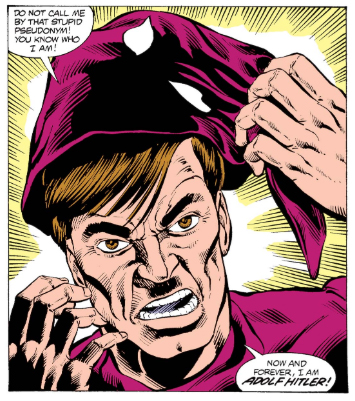 Suddenly Doom's victory and Magneto's plan both seem very sensible - we'll see how it all works out next time!
Suddenly Doom's victory and Magneto's plan both seem very sensible - we'll see how it all works out next time!
posted 4/10/2019 by MJ Hibbett
(click here for permanent link)
(0) comments
Dreadknight And The Daughter Of Creation
This time we're looking at a brief, but important, cameo from Doctor Doom in what turns out to be a very mid-70s issue of 'Iron Man', in that it features Frankenstein's monster, Jack of Hearts, characters who cross the line between heroes and villains, and of course a script written by Bill Mantlo!
The main story sees Iron Man being attacked in Castle Frankenstein by an armoured baddy called The Dreadknight, who has turned up on a mutated version of the original Black Knight's flying horse to steal the secrets of Frankenstein from his great granddaughter, who is currently using his discoveries to nurse some "dwarfish mutants" called The Children. As I say, it's very mid-70s Marvel!
Doctor Doom appears in the middle section when we learn the origin of The Dreadknight, who appears to have been called Bram Velsing.
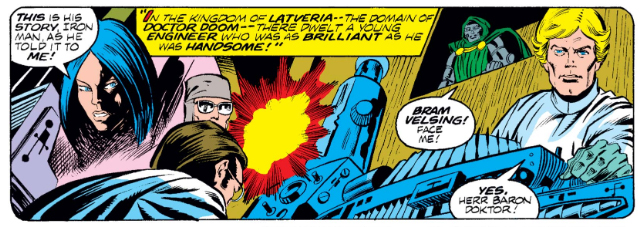 I'm a big fan of Bill Mantlo's work, but I have to admit he could have worked a bit harder thinking up a name!
I'm a big fan of Bill Mantlo's work, but I have to admit he could have worked a bit harder thinking up a name!
Bram Velsing works for Doctor Doom who, like so many bosses, tells him off for daydreaming on the job. Unlike so many bosses, however, Doom is at least honest about who does get to daydream.
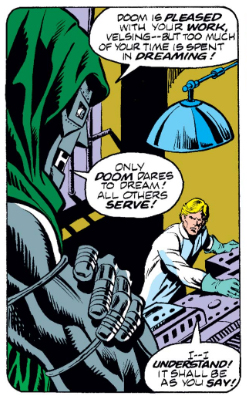 Bram Velsing rapidly gets sick of this, and decides to steal back his inventions and take over Latveria for himself. His girlfriend Maria begs him not to as its too dangerous and is proved right when Doom himself appears.
Bram Velsing rapidly gets sick of this, and decides to steal back his inventions and take over Latveria for himself. His girlfriend Maria begs him not to as its too dangerous and is proved right when Doom himself appears.
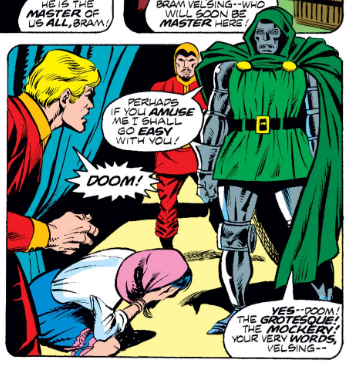 Doom orders his men to take Maria back to her family unharmed - she was, after all, trying to warn Velsing not to defy him, so it makes sense from his point of view to let her go home and repeat the story to others. It's very much in line with Doom's current characterisation as a reasonably sane-ish dictator, but then things rapidly change when Doom reveals Velsing's fate.
Doom orders his men to take Maria back to her family unharmed - she was, after all, trying to warn Velsing not to defy him, so it makes sense from his point of view to let her go home and repeat the story to others. It's very much in line with Doom's current characterisation as a reasonably sane-ish dictator, but then things rapidly change when Doom reveals Velsing's fate.
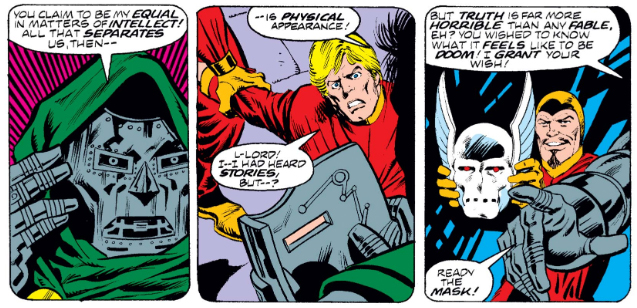 (note, by the way, that George Tuska includes Doom's ring on his gauntlet - something which is almost always missed out and is a lovely bit of non-essential detail here. Also Velsing does not actually say Doom is ugly, he's just surprised that he's not like the stories - tying in nicely with Kirby's preferred interpretation that Doom isn't really that scarred at all).
(note, by the way, that George Tuska includes Doom's ring on his gauntlet - something which is almost always missed out and is a lovely bit of non-essential detail here. Also Velsing does not actually say Doom is ugly, he's just surprised that he's not like the stories - tying in nicely with Kirby's preferred interpretation that Doom isn't really that scarred at all).
The mask is fixed to his face using a "bio-fuser" which means that it can never be removed. Doom says this will make them alike, but we've seen on the same page that Doom CAN take off his mask! This is more in line with the alternate tradition of Doom as utter lunatic - there's no possible gain for him in punishing Velsing in this way, nor any reason why he should have such a mask to hand or why it should have giant wings on it.
Velsing staggers away, apparently set free, and staggers for "days - weeks" (he's not sure) to Castle Frankenstein (keeping the geography sensibly vague) until he's rescued by Frankenstein's great grand-daughter, who happens to have found and mutated the original Black Knight's flying horse and gives it to him as a present.
Doom does not reappear, and the Dreadknight ends up being injured in battle and is left in the care of Frankenstein's Monster and The Baronness, who have fallen in love with each other over the course of the story. Once again - very very mid-70s Marvel!
posted 2/10/2019 by MJ Hibbett
(click here for permanent link)
(0) comments